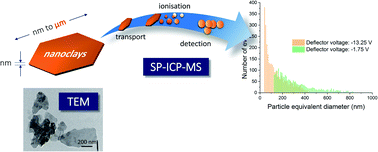Exploring the boundaries in the analysis of large particles by single particle inductively coupled plasma mass spectrometry: application to nanoclays†
Abstract
The analysis of microparticles by single particle inductively coupled plasma mass spectrometry (SP-ICP-MS) requires sample introduction systems that guarantee transport efficiencies similar to those obtained with dissolved standards across the size range covered. The utilization of a nebulisation system based on a linear pass spray chamber and a micronebuliser is discussed and optimized for the introduction of large inorganic particles. Limitations caused by incomplete ionisation or the counting limit of detectors affecting particle size characterisation are also considered. The procedure developed has been applied to the characterisation of suspensions of a natural clay (kaolinite), with a thickness in the range of a few nanometers and lateral dimensions up to 1 μm. The application of different sensitivity conditions by the modification of the ion transmission allowed us to cover the whole size range of the suspension monitoring the 27Al isotope and achieve a quantitative mass recovery with respect to ICP-MS analysis. Finally, the migration of nanoclays (montmorillonite) from food containers and their detection by SP-ICP-MS are presented. The results have been compared to those obtained by TEM, showing that nanoclays migrated from the containers into water.

- This article is part of the themed collection: Community Leaders: Ramon Barnes


 Please wait while we load your content...
Please wait while we load your content...